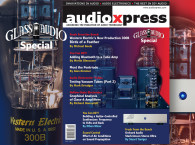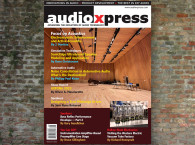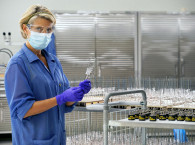
I shall focus solely on the 2021 production Western Electric 300Bs and their behavior and quality — comparing them a bit to older “Western Electric originals” and to some third-party 300B clones. With that said, my review shall begin with my journey into the 300B and single-ended triode (SET) amplification world.
My Experiences with Tubes
I have been using electron tubes for audio amplification since my early youth in the 1970s, beginning with amplifiers built from the leftovers of tubed radio receivers, TV sets, and other electronics from scrap yards or surplus sales. Then, I graduated to more ambitious projects with higher quality components and less random circuits. Over time, I have designed, built, and measured many amplifiers and topologies, vacuum tube, hybrid, and solid state, both small signal and power, from microphone amplifiers to kilowatt (kW)-power modulation amplifiers for AM transmitters. Most of the time, I have used solidly engineered circuits with negative feedback (NFB) and other measures to keep amplifier behavior stable and tolerant to component tolerances and aging, and to ascertain good measured parameters.
Eventually, I have learned that while measurements give an idea on the technical performance of amplifiers and their behavior in specific situations, the best measured amplifier is not always the one that sounds most pleasant and engaging — through that I came across the return to “simple” single-ended amplification driven first by Japanese audio enthusiasts, spilling over to the US and Europe. In the 1990s, I had the chance to listen to a number of systems using such amplifiers, and while the sound of many of these systems did not agree with my taste, others did, and to a degree that I found worthwhile to investigate. In 1999 I came across Jean Hiraga’s book Initiation aux amplis à tubes [3], and, following that, started to build single-ended amplifiers with the 300B tube.
Initially I copied circuits from the magazines and the Internet, using “cheap and cheerful” Russian and Chinese 300Bs, quickly finding that I did not like these amplifiers as much as some that I had heard elsewhere, or my “conventionally engineered” push-pull and OTL amplifiers. But then, after positive listening experiences with some other enthusiasts’ systems, I decided to dig deeper, and try and measure other driver topologies and “better” 300Bs.
Over time, I built up quite a collection of 300B tubes (Chinese, Russian, Czech, and Slovak clones of “improved” versions, as well as several pairs of Westrex Western Electric reissues produced in the Kansas City factory in the late 1990s, and two “old stock” WEs traded for some West German broadcast amplifiers), and tested them extensively. The tests confirmed the findings found in J. C. Verdier’s article — many samples in the market are of rather inferior quality and have a much shorter service life than those rated for the WE “Originals.”
By 2008 I had developed a “reference” amplifier topology, which delivered the sound and measurement results I had been looking for, naming it the “MB300+,” as it could as well accommodate a range of other directly heated triodes. I found that, when demonstrated at amateur audio events, the amplifier did perform quite well in comparison to other amateur and some commercial products available for direct comparison. In 2009, during the European Triode Festival, I presented measurement results of various 300B clones and originals in this amplifier and allowed comparative playback of music. At the festival, the Westrex WE 300B reissues from 1999 were rated highest by the audience. The listening results interestingly did correlate well with Peter van Willenswaard’s 1999 findings—second rated were Czech “boutique” 300B clones, which I actually favor myself. At that time, and after the factory move from Kansas City, MO, to Huntsville, AL, the supply of Westrex Western Electric 300B clones had all but dried up — forcing people to look for alternatives.
Since 1999, high-grade clones from China and other places have entered the market, some of them allegedly close to the original Western Electric or 1990s Westrex Western Electric production, but despite the high price, in general they do not meet the lifetime expectation of the WE originals (rated for 40,000 hours at my favored operating point). Users who wanted to stay with WE original products were forced to take the risk and purchase new-old stock (NOS) at very high and ever-increasing prices, which were not backed by factory warranties any more; or they could use stock they still had, as long as it lasted — like me, sparingly using my old stock samples acquired in 2001.
So, when I learned that a new production facility had been set up in Rossville, and production had restarted using the old construction diagrams, 1962 recipes for the cathode chemistry, and new/updated machinery and test equipment, I thought this to be good news, but was a bit skeptical about the chances for success — setting up a proper production of vacuum tubes is difficult. Refer back to the J. C. Verdier article and the problems outlined in there for more detailed information.

The WE 300B Tubes
In March 2021, audioXpress asked me if I would like to review a pair of tubes from the Rossville production and rate them in comparison to the old ones. Understandably, I was quite enthusiastic about that request, and said yes right away.
For me, it was immediately clear that I needed to critically assess if the new production samples met the expectations one would have for such products, which, with the WE name, and backed by a five-year warranty, still command a rather high price.
So I set up a test plan — get them, burn them in in same way the 1999 production samples had to be burned in (see Peter van Willenswaard’s article on the need for burn-in and the justification for it), testing and measuring them during the process—and keep running them for as many hours as possible afterward to glean at the long-term stability of the characteristic parameters.
After getting the tubes out of Dutch Customs in early April 2021, I carefully unpacked them. They came well packed, a bit like Matryoshka dolls, with several layers of cardboard and bubble foil covering a small cardboard box that contained a wooded box that in turn contained two cardboard boxes with the actual WE 300B tubes inside, with matching foam inserts to properly protect them, and ancillary documentation including individual test charts for each tube. This packaging is pretty much the same as the one used for the 1990s Westrex Western Electric production tubes.
The tubes are shown boxed in Photo 1 and unboxed in Photo 2. The wooden box may be a bit over the top, but it is still a nice touch, and the overall packing is very well done — I have seen comparable quality only in the packaging of certain Japanese and Czech “boutique” 300Bs, but none reach the Western Electric level of sophistication.

The individual test charts delivered with the WE 300B tubes (Photo 3) show tubes within datasheet specification (median values in datasheet of 300B [4] — by experience, one sigma deviation of primary parameters is better than ±1/6th). As visible in Photo 3, my 1999 reference pair (measured and delivered in 2001) had a slightly lower Rp in the factory test operating point (due to higher gm). WE factory matching for both old and new production was done to mu and Rp. It is of note that the test rig used in factory in 2021 has a better resolution than the one used in the factory in 2001. Furthermore, the curves point to a subtle difference in the grid structure of the 2021 production 300B compared to my 1999 samples — the current cut-off at very high plate voltages is less sharp than in the 1999 samples. This is, however, not a problem in real use — I have seen similar behavior with my old stock (1970s) WE 300B, without detriment in sound or measured distortion performance.
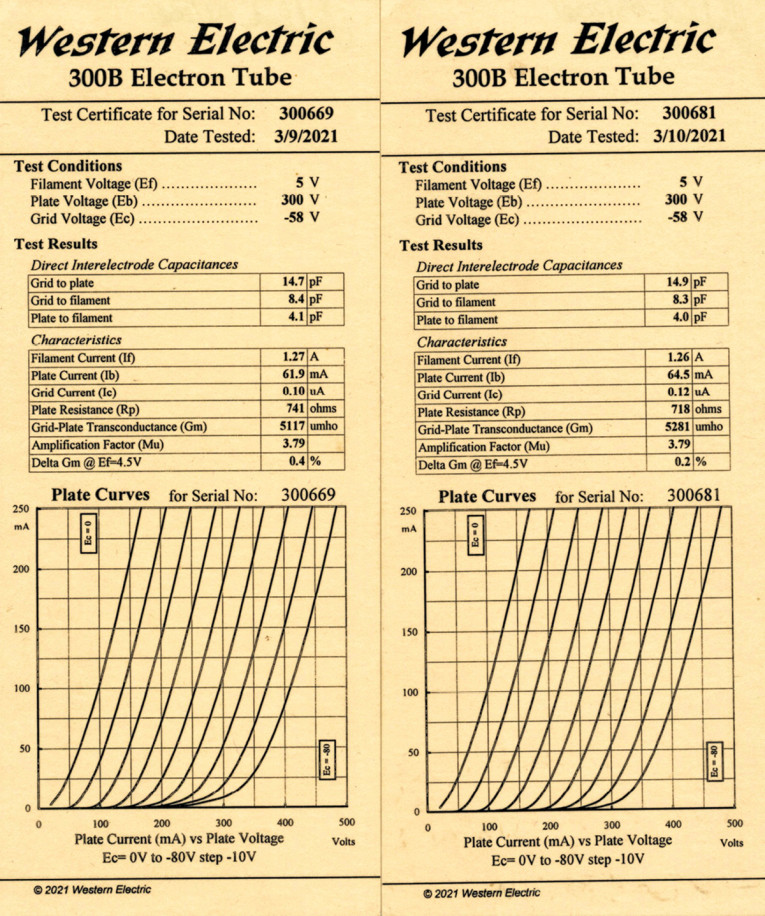
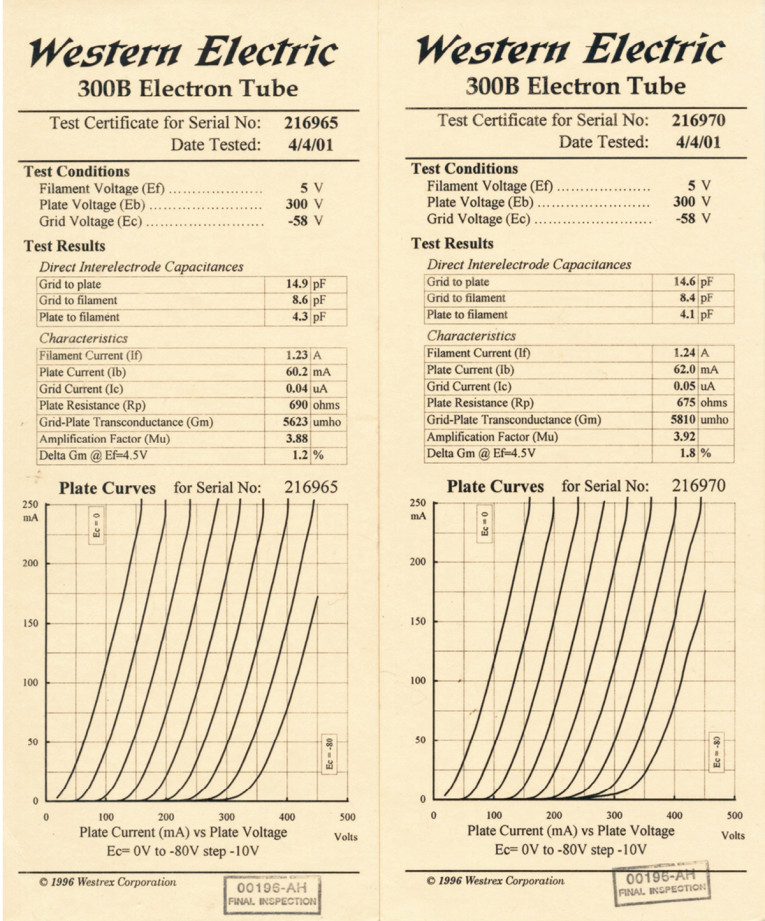
Photo 3: Individual test charts come delivered with the WE 300B tubes. Shown here are 2021 Rossville (a) and 1999 Kansas City (b) production charts.
A quick plausibility check for the curves was done by calculating the perveance of the tubes at low grid and plate voltages, and then extrapolating the plate current at some higher values, using the Child-Langmuir space charge equation and the appropriate dynamic mu figures from the datasheets [4], [5]. The calculated values were close to the values indicated in the curves, thus confirming the validity of the curves. With this, I considered the visual inspection passed successfully.
Testing
The visual inspections were followed by a check of the basic parameters on my electron tube test rig (described in the annex) in the test point given in the tube test charts. After 30 minutes warm-up, the basic parameters as indicated in the test charts, including the filament current at 5V, were reached within the test rigs tolerances. It is of note that the curves indicated both 2021 samples being at the bottom end of the allowable tolerance field of the datasheet. For evaluating the perveance, a pulsed emission current test cycle was done at 200V (grid negative at -100V, pulsed to 0V at 100 Hz and 10% duty cycle)—the pulsed current of the tubes reached 310mA (1st) and 320mA (2nd) — median in the datasheet is 340mA.
After that, the new tubes were given a hard stability test — running them for about 100 hours at 36W plate dissipation (operating point 360V/100mA with grid servo regulator), which they passed without problems. Then, static parameters were measured again—notably, dynamic mu remained unchanged within the tolerances of the test rig, but the perveance had slightly gone up, requiring slightly higher negative grid voltages to keep the plate current at 60mA — gm had increased by a few percent, and the grid current had gone down noticeably. This presumably is because the getters had caught more gas ions in the bulb, activated through the dissipated heat.
I then made a first set of distortion measurements after warming up the tubes in the measurement amplifier for 30 minutes. The distortion measurement system is described in the sidebar at the end of the article and shown in Photo 4. Overall, the tubes reached the datasheet specification for the operating point of the test amplifier (WE 300A datasheet, page 5 — recommended operating conditions — at 350V/60mA/7W, 1dB below clipping: h2 below minus 30dBr, h3 below minus 44dBr referred to the fundamental), but with relatively high levels of high-order harmonics — tailing off fast, but with significant levels up to h9 — see Figure 1, column 2, position 1.
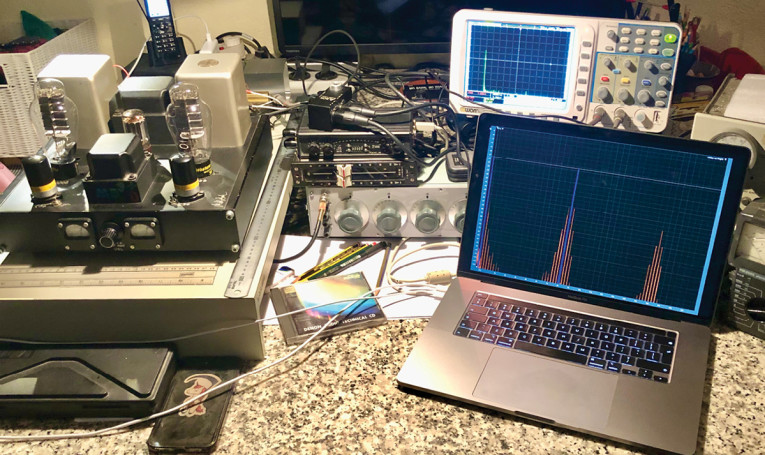
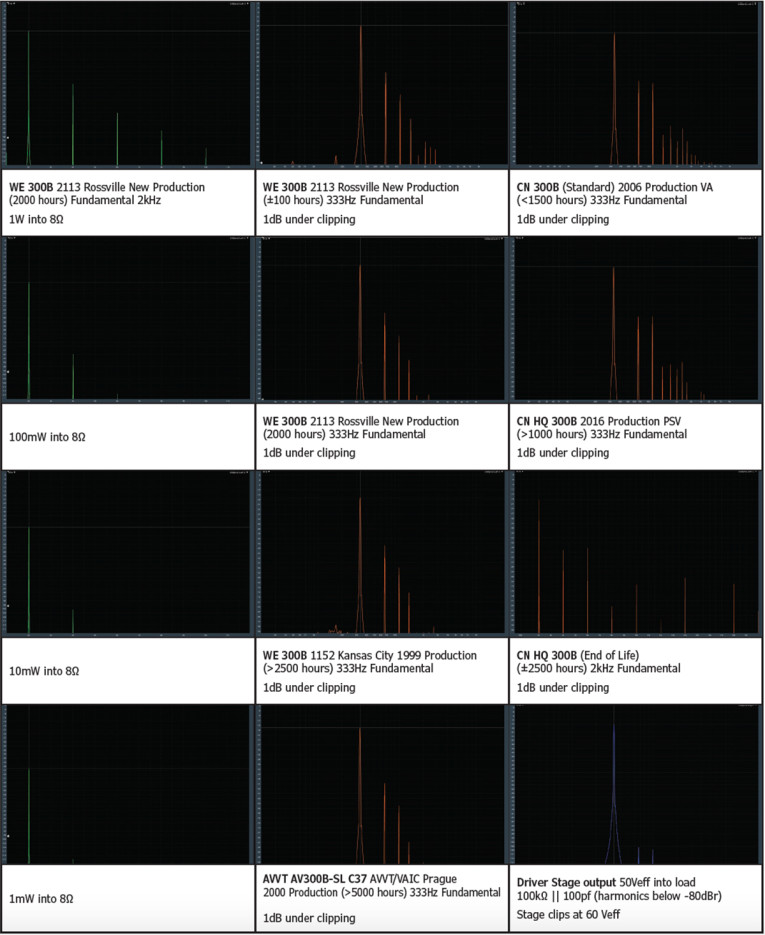
The tubes were then inserted into the amplifier used for the listening tests and used for about 400 hours. Thereafter the basic parameters were measured again in the test rig. By that time, the perveance had gone up further, again requiring alignment of the grid bias voltages—total change required now about 5% to keep the plate current at 60mA. The mutual conductance gm had increased by about 5%, dynamic mu remained unchanged, and the ionic grid current had gone down on both tubes below 70 nA. In the pulsed emission test, the pulsed current now reached at least 340mA on both tubes, thus bringing their perveance to a good average value — the cathodes being activated to full performance in the about 500 hours total operating time.
Distortion measurements were repeated, and showed a notable reduction in higher-order harmonics, all components above h5 disappearing in the noise floor, closing in to the distribution shown in Figure 1, column 2, position 2.
After that, the tubes were reinserted into the main amplifier and used for listening for about another 2000 hours before being measured again in December 2021, bringing the total operating hours to about 2500.
The basic parameters — mutual conductance, dynamic mu, operating point, perveance, within the tolerances of the test rig — remained essentially unchanged to the measurements at 500 hours. The filament current remained unchanged at 5V filament voltage. The residual grid current had further gone down to about 65nA, pointing to a very good vacuum and little contamination of the glass surfaces with evaporated cathode material.
These measurement results are very good so I concluded that the tubes still have a long service life ahead. The advertised long-life expectation seems more realistic after these measurements.
For comparison, I had some less promising experience with low-price Chinese and Russian 300B clones, with many not even reaching 2000 hours before end of useful service life (emission dropped, mutual conductance down more than 30% compared to new tube), and with others, “boutique” 300Bs included, rather alarming total failures due to filament breakage, failure of the filament tensioning springs or thermal runaway due to cathode material deposited on the glass surfaces, forming low resistance connections between anode and grid, pulling the tubes into “latch up”-like conditions.
At this point, concluding that burn-in had been successfully finished, more distortion measurements were performed. The results are shown in Figure 1, column 1, showing harmonic spectra at 1W, 100mW, 10mW and 1mW. It is noticeable that even at 1W, higher-order harmonics tail off fast, and will most likely be masked by the distortion of speaker and ears of the listener, if a sufficiently sensitive loudspeaker is used. I recommend a minimum of 95db (1m, 1W), and the distortion tails off quickly at reduced power.
For comparison, distortion spectra of various 300Bs 1dB below clipping point are given in
Figure 1, column 2, position 1–4 and column 3, position 1–3.
The spectral distribution varies significantly between different 300B “incarnations” — the fast tail-off of higher-order harmonics is achieved in a properly burned-in Western Electric 300B. Note the similarity between the 2021 Rossville production and the 1999 Kansas City production examples, and the comparable tail-off in the Czech “boutique” 300B. For comparison, the sample Chinese 300Bs showed quite a different distribution of the higher-order harmonics. The differences in sound are not insignificant. Of note is the spectrum shown in Figure 1, column 3, position 3 — the tube has reached end of life (it clips significantly earlier than the other samples, input signal was reduced accordingly). More higher-order harmonics are visible, as the dynamic mu is no longer near constant.
However, the fast harmonic distortion tail-off can only be achieved if the output transformer used has inherently low distortion, the connected load or speaker has a flat impedance characteristic (I recommend speaker impedance correction/linearization networks in the crossovers, even for broadband speakers), and if the driver stage does not deliver high level of harmonics in itself, masking the actual behavior of the output valve.
In Figure 1, column 3, position 4, the behavior of the driver of the test amplifier is shown. It actually produces hardly any relevant harmonics, with all harmonics being at least 80dB below the fundamental, thus not adding significant high-order harmonics to the output signal spectrum.
The quick tail-off of higher-order harmonics is important for the correct processing of (complex) music signals, as music signals contain many frequencies at once, leading to intermodulation distortion (IMD), read: the mixing of signals by the nonlinearities of the amplifier. Intermodulation of higher-order harmonics bears no harmonic relationship to the actual tones in the music, thus making them disturbing to the listener. For demonstrating the good behavior of the reviewed 2021 Rossville production WE 300Bs, even a bit better than the measured 1999 Kansas City WE 300Bs, please refer to the IMD spectra in Figure 2, column 1 and column 2. For comparison, the IMD spectrum of a high-quality Chinese 300B is presented in Figure 2, column 3. The tail-off of sideband spectra is much faster than the tail-off shown by the high quality Chinese 300B — promising a ”cleaner” behavior with complex music.
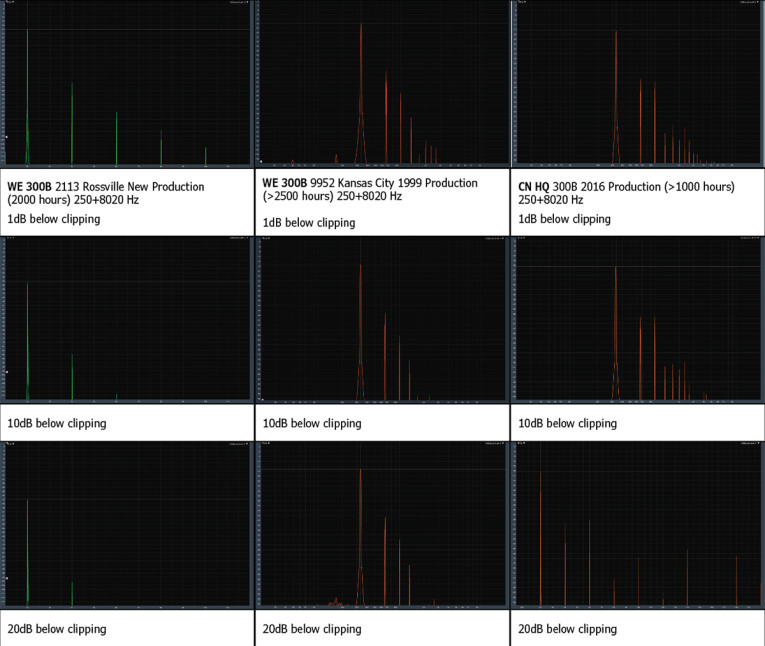
Listening Tests
For the listening tests, I have used my “living room” system, described below in the annex. I regularly listen either with the EL34PP or the 300B single-ended amps driving the Tannoy monitors, alternatively with the 6S33S-V Circlotron OTLs driving the Sonus Faber Guarneri monitors, depending on music type and playback levels. The EL34PP and the 6S33S-V OTL amps were used for “sanity tests” connected to my preamp individually via Eckmiller MR90-St-D faders for adjusting the SPL at the listening position. Adjustment was done with one-third octave noise 800Hz to 1250Hz from the Denon Audio Technical CD (Denon 38C39-7147) and a Brüel & Kjær (B&K) integrating SPL meter at 84dB SPL, to better than 0.5dB, and repeated for each 300B pair used in the setup, as there are noticeable individual gain differences between various 300B types — not so much between WE 1999 Kansas City and WE 2021 Rossville production samples—between those, no realignment was required.
Note: 84dB SPL at -9 dBFs (i. e., leaving 9dB headroom as per EBU specification) is fairly demanding on the amplifier—with my listening distance of 3.5m from the speakers and the speaker’s sensitivity of 95dB(1m) at 1W, the amplifier reaches the onset of clipping at 0dBFS, which is technically optimal, but emphasizes that with a standard 300B amplifier, high sensitivity speakers are required. Real listening is on most occasions taking place at significant lower SPL values.
Of note is the history and layout of the 300B amplifier for the listening tests.
In 2017, I built a single-ended 300B amplifier to be used first for a system at the European Triode Festival and then to become part of my “living room” setup. To build it, I used high-grade components I had collected over the years, including Tamura F-7002 Permalloy core output transformers, Lundahl small signal transformers, Unitran and Stoet power transformer and chokes, Welwyn, Beyschlag, Bourns, Dale, and Allen-Bradley resistors, Westermann, Roederstein, Siemens, Jensen, Black Gate, and NCC capacitors, and other selected (new) old stock active and mechanical components. The circuit implements all the experiences I had gained over two decades of building DHT amplifiers in various topologies, and, to use an old adage, was designed to be “as simple as possible, as complex as necessary.”
As it is a further development of my measurement amplifier, streamlining the circuit, I named it “MB300+ Generation 2.” The amplifier uses a low distortion pentode driver stage built around the C3o (German Post Office line driver pentode) with local NFB, Lundahl input transformers to isolate the inputs and prevent ground loops, a hard LC/shunt regulated power supply for B+, heavy decoupling for other supply voltages and regulated DC power supplies for the 300B filaments. All stages are run in Class A1. The driver is optimized to low distortion up to the clipping point of the 300B power stage (onset of grid current), keeping THD and IMD of the driver stage very low up to that point — at 50 Veff driver output into 100 kΩ||100pF, all harmonics are below -80dB relative to the fundamental, h3 being the dominant one, higher-order harmonics quickly tailing off. Driver stage IMD is very low as well. As the 300B power stage is not meant to be driven into the grid current regime (Class A2), coupling from the driver to the 300B is capacitive, defining the clipping point by the onset of grid current of the 300B. Due to the high level of filtering and low overall gain, the noise floor is very low. The amplifier is shown in Photo 5.

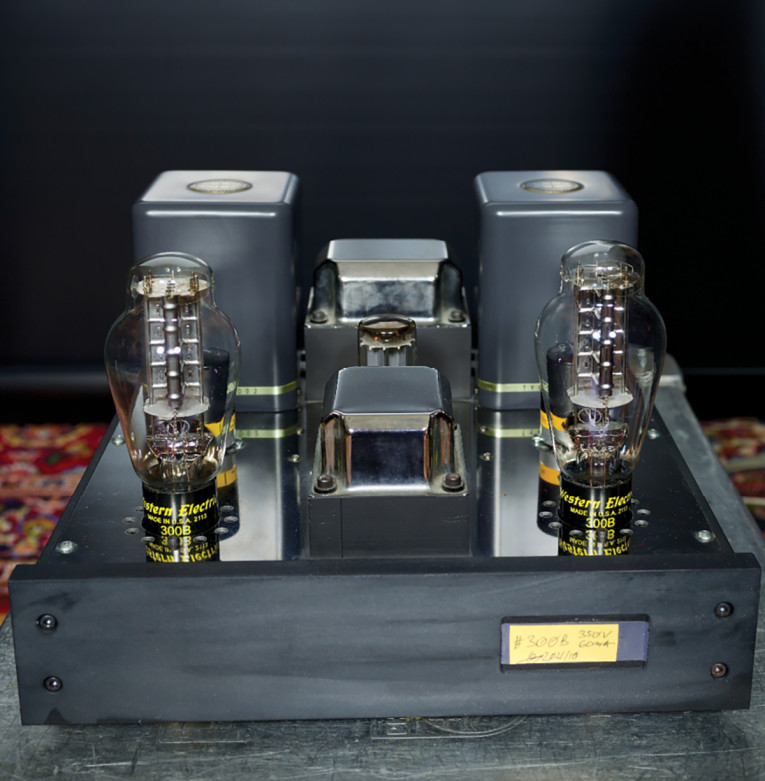
As a consequence of the low driver stage distortion and IMD, its sonic signature is inherently different from many common 300B amplifiers. It is cleaner, less colored, less warm, and less euphonic than most 300B amplifiers with cascaded triode/SRPP/Loftin-White drivers, but also less forgiving to “sub-standard“ 300B tubes, as the sound is dominated by the behavior and distortion spectra of the 300B power stage rather than by the high level of harmonics and intermodulation from typical drivers. In that aspect, behavior is comparable to the amplifier used for the measurements.
Because of that, during listening, “the signature,” read IMD distortion and grid current behavior of the 300B used in the power stage, becomes rather easily discernible. I normally operate it with Czech “boutique” 300B clones, and put in my old stock WE 300B on occasion, for listening pleasure.
A suitably long burn-in time for the 2021 Rossville WE 300Bs (and other 300Bs that use the dual carbonate cathode chemistry as described in Peter van Willenswaard’s article) is necessary, not only for improving measurement results, but as well for achieving the best possible sound quality. Critical listening let me experience this (requiring A/B swapping of warmed-up tubes, which is not recommended for normal use, as there is always a risk of broken filaments and of burns to the person changing the tubes).
For the first few hundred hours, the WEs sounded a bit lackluster, forward and less resolved than my reference samples that had been used for a long time. Over time they slowly opened up, reaching a good level of performance, which they have held ever since.
The 2021 samples have at last reached a behavior very close to my reference samples (1999 Kansas City and old stock 1970s Kansas City WE 300B). They do not sound exactly equal, but share overall behavior very closely — they are family though, birds of a feather. The differences are subtle, and caused by normal production tolerances — see the IMD measurement in Figure 2 and the curves in Photo 3)—for most uses, I deem them not significant.
For the review I listened to various types of music on the system shown in Photo 6, from complex classical recordings to modern lounge jazz, natural voice, acoustic and electronically amplified/enhanced instruments, and electronic music, with good recordings but as well some with errors audible in good reproduction systems.
I think that using such “imperfect” music samples, and confirming the discernibility of said errors is an important benchmark for reviewing sound reproduction performance of reproduction systems and components therein, including electron tubes. I note that no reproduction system I ever listened to did fully accurately reproduce live sound of acoustic instruments. The best systems produce a plausible representation or, as I like to call it, an acceptable sonic illusion, and this is what I am looking for in listening.

Overall Impressions
The overall impression in my system was that with the 2021 Rossville WE 300B, the music was represented correctly, producing a suitable illusion and immersive experience — much in line with what was achieved with old production WE 300B and the Czech “boutique” 300Bs that I regularly use. The WEs showed a more forward, engaging representation of the music’s mid-range, while the Czech 300Bs seemed more wide-band, showing more emphasis and details in the frequency extremes (Note: the dynamic internal resistance of the Czech tubes was lower than those of the WEs, thus changing the interaction with output transformer and loudspeaker, which is bound to change the sound).
Both the WEs of old and new production and the Czech “boutique” 300Bs presented the music as recorded, not adding information, and not glossing over recording or musician’s errors. Compared to some other, “lesser” 300Bs clones, the representation of the music was more transparent, allowing to listen “through” complex passages in the music, without becoming overly analytical. Entry-level 300Bs clones sounded sometimes more euphonic with small, not too complex settings, but quickly became muddy in complex parts (most likely owing to the higher level of IMD).
Thus prejudiced positively by my own listening, I put the tubes to another “hard” listening test by carrying them, together with amplifiers, speakers, preamp, sources, cables, assorted recordings on CD and CD-ROM and a bunch of different high-grade 300B clones and “improved” types to an audio festival with international participation held in France in November 2021 (as my review covers a new commercial product, the organizers asked not to mention the name of said event). The goal was to have a larger audience of experienced and critical listeners partake, to corroborate or contradict my impressions. I brought along my two remaining 300B Amplifiers—the MB300+ and the MB300+-Generation 2. The system as used and presented at the festival is shown in Photo 7.

The resulting comments were in line with what I had found myself. The new production WE 300B were in general perceived as WE “family members” and the majority positively commented upon them — from “if you had not disclosed them as new production, I would have considered them as good old stock samples” to “subtly different, but clearly from the family”and one outlier “the difference to the 1999 samples is not subtle, but much less than to third-party clones.” The common denominator was that the tonality and the voicing of the system with the new production WE 300B was very rich and engaging, but precise at the same time — producing a worthy sonic illusion.
The system held up over various levels of loudness, while some other 300B clones did not sound “right” at some levels, either being unengaging at low levels, with the loudness threshold required to be passed to create an acceptable level of illusion, or falling apart and sounding unpleasant at higher level. In general, the “WE 300-B sound” for both 2021 and 1999 WE production samples was favored, followed by the sound of the Czech “boutique” 300Bs.
Conclusion
I enjoyed reviewing the Western Electric 2021 Rossville production WE 300B tubes, both the measurement and the listening parts. I pushed the tubes through their paces, hard, and did not find the experience wanting.
The new production WE 300B samples reviewed are good, even very good. After burn-in, they have been very close to my 1999 WE 300B “reference” samples still produced in the Kansas City factory, enough so to be called birds of a feather. There are subtle differences driven by the deviations in characteristic curves, read mutual conductance, gain factor, and internal resistance. It is noted that these deviations are well within the expected production tolerances as per old production datasheet specifications.
From the beginning, measurement of characteristic parameters (operating points, gm, mu, leakage currents, perveance, and perveance drop when filament voltage is reduced) were in line with the individual acceptance test charts delivered with the valves. In line with lore and expectations, they took more than 300 hours of burn-in to stabilize sonically. In measurement, perveance and gm increased to datasheet average values over that time, and the grid leakage current went down by almost 50%, pointing to the already good vacuum improving — THD and IMD characteristics improved a bit as a consequence — in my opinion that accounts for the improvement of the sound over this burn-in period.
After that, the review samples have kept up very well during the more than 2500 hours they have been used for thus far, with no visible ageing after burn-in. The perveance and mutual conductance have remained unchanged, within the tolerances of my measurement setup, and the isolation resistances and vacuum have held up as well — so it is fair to expect the tubes to last very long, making the five years manufacturer’s warranty a realistic provision.
As for the “sound” provided in my setup, the tubes clearly belong to the Western Electric family. Again, there are subtle differences to the WE old stock and to the 1999 WE Kansas City production samples, but they are at level that manifests themselves only by direct comparison (A/B swap of burned in and warmed up tubes).
If the production line and process remain stable, and average new production tubes have similar properties to the ones reviewed, potential buyers will receive a quality product that lives up to its name, backed by a meaningful long-term warranty. Thus, the risk taken seems low when compared to the purchase of NOS WE 300B tubes on the market or the purchase of high-priced third-party “high-grade” clones. I also noted that the 2021 WE 300Bs — in my system as described in this article — did sound good with all the music samples from a wide range of genres, and over a wide range of volumes on mid-high efficiency loudspeakers.
This article was originally published in audioXpress, May 2022
References
[1] P. van Willenswaard, “In Search of the Perfect 300B Tube,” Stereophile, November 1999, www.stereophile.com/features/229/index.html
[2] J.C. Verdier, “Kinky Triodes - 300Bs investigated - Article on 300B tube production quality and typical problems found with actual production tubes,” Sound Practises, Issue 16, www.jcverdier.com/ADSL/kin300EN.html
[3] J. Hiraga, Initiation aux amplis à tubes, (ISBN 978-2100041169)
[4] Western Electric, WE 300B Datasheet, https://frank.pocnet.net/sheets/084/3/300B.pdf
[5] Western Electric, WE 300A Datasheet, https://frank.pocnet.net/sheets/136/3/300A.pdf
See page two for the List of Equipment used in this Review.
 About the Author
About the AuthorMichael Boele is a German-born Telecommunications and Electronics Engineer (Dipl.-Ing. TH (Nachrichtentechnik), MSEE) who has been working on ground and ground-to-space communications and navigation. He acquired his MSc degree in the 1980s, and worked on measurement and control systems for high voltage electrical power distribution systems and on RF/communications measurement systems. In his professional life, he moved away from electronic hardware design, and — to keep his dexterity in this field — he took up collecting tubes and designing audio amplifiers and test equipment. Over the last 25 years, he has designed many small signal and power amplifiers, push-pull and single ended, tube-based, and hybrid, and is considered by some as a living database on electron tubes and their uses. He built his first 300B SET amplifier after reading Jean Hiraga’s "Initiation Aux Amplis À Tubes" in 1999, first intrigued, not expecting much, but being positively surprised. He has been building more of them over the years, using measurements and listening experience for their optimization, acquiring many “incarnations” of Western Electric 300B tubes and clones, some Western Electric old stock originals, some Western Electric re-issues and many third-party 300B clones striving to meet original specification as well as “improved” types.



